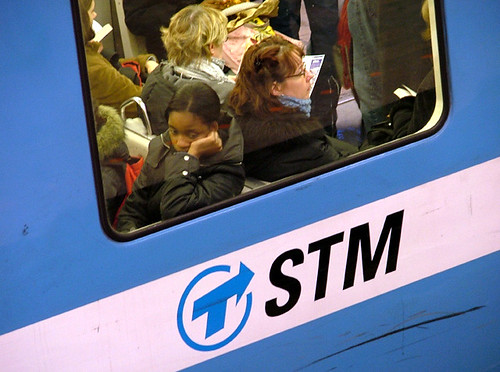Montrealers are full of complaints. Sometimes they’re even willing to fill out of a form to make an official complaint, which is what 326 people have done in response to the STM’s last round of fare hikes at the beginning of this year. But that’s not all they’re unhappy with: transit users are now complaining that the Laval extension has made the metro too crowded and that the STM isn’t doing enough to keep up with the increased ridership.
When the Laval metro opened in April, its three stations were expected to be used by a combined 34,000 riders per day. Just over half a year later, that projection has been surpassed, with 45,000 passengers boarding trains at Cartier, de la Concorde and Montmorency stations. In response, the STM has increased the number of trains that serve the orange line at rush hour, but it still isn’t enough to keep up with demand.
It’s an appropriate time, then, for the two commissions in charge of examining Montreal’s new transport plan to release their final report, which is what they did last week. Between them, the opaquely-named Commission du conseil municipal and Commission permanente du conseil d’agglomération made 150 recommendations drawn from a series of public consultations held earlier this fall. Most notably, they suggest reinstating bridge tolls; reducing the number of non-residential parking spaces; extending the blue line east to Pie IX; and building three tramway lines, along Park Avenue, Côte des Neiges Road and around the Old Port. None of these ideas are particularly revolutionary — they’ve all been discussed in detail over the past few years — but they’re seen as necessary if the city hopes to achieve its goal of reducing the number of car trips made in Montreal by 20 percent before 2021.
There aren’t any new orange line trains on the horizon, though — those will have to wait until after the new green line trains are delivered in a few years.
You can read more about the official transport plan, which was released last May, on the city’s website.


4 comments
I have to be I’m in the first one to be surprised and it brings me a few questions.
Was there so many people taking the metro at Henri-Bourassa?
How many of these 45 000 people actually abandoned their cars for the metro?
Are these mostly students or workers?
Do people travel from Laval stations to Laval stations for work or school? I remember when I was in High school going from Verdun Station to Lasalle Station, both in Verdun.
And finally the great question
Is this news a good thing or a bad thing? Because the article shows it as a bad thing so i’m confused
Interesting how none of the recommendations you mention will alleviate the situation with Laval riders–in fact, tolls will only worsen it!
Tactics to reduce inner-city car traffic like tolls and reducing parking are great ideas, but only if they’re matched by increases in the accessibility and attractiveness of public transit.
Time to revive other ideas for the Laval quandry, such as:
– increasing the frequency and extending the hours of the suburban train services to Deux-Montagnes and Blainville/St-Jérôme, especially the latter so as to match the former
– continuing the other branch of the orange line, at least until Bois-Franc, to help Sainte-Dorothée residents get to the metro faster
– changing the route of the Blainville/St-Jérôme line to take the tunnel under Mount Royal and share with the Deux-Montagnes line (and the tunelling and track laying required to make the connection possible)
At this rate, I suspect that the rush-hour short turn at Henri-Bourassa isn’t going to last very long.
With all the gentrification and skyscraper condos being built it is only going to get worse. More cars too. I left town 7 years ago and recently returned. Montreal has become too pricey and congested. It takes too long to do the simplest errands. It is not worth me staying